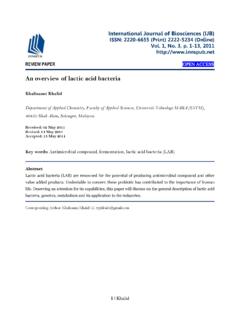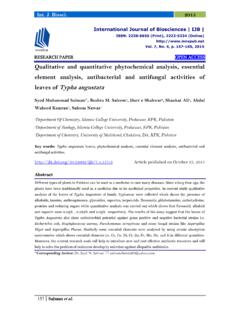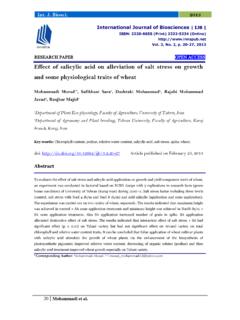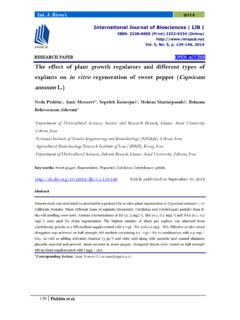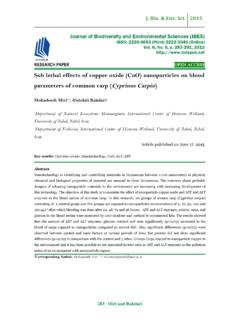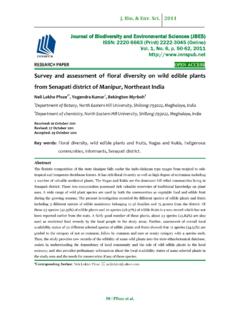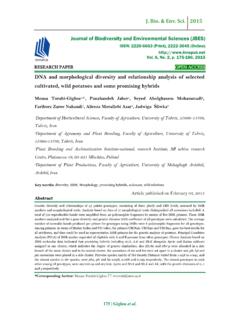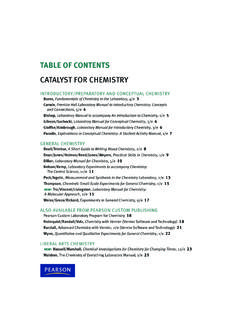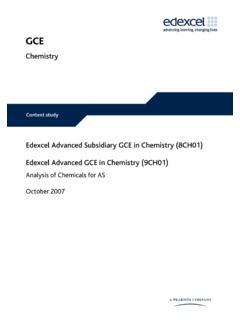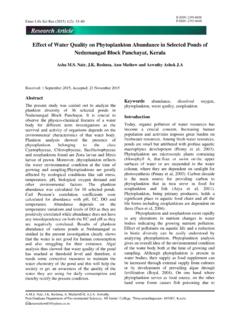Transcription of Status of selected physicochemical properties of …
1 J. Bio. & Env. Sci. 2012. Journal of Biodiversity and Environmental Sciences (JBES). ISSN: 2220-6663 (Print) 2222-3045 (Online). Vol. 2, No. 3, p. 57-71, 2012. RESEARCH PAPER OPEN ACCESS. Status of selected physicochemical properties of soils under different land use systems of Western Oromia, Ethiopia Achalu Chimdi1*, Heluf Gebrekidan2, Kibebew Kibret2, Abi Tadesse2. 1. Wollega University, P. O. Box 395, Nekemte, Ethiopia 2. Haramaya University, School of Natural Resources Management and Environmental Sciences, P. O .Box 138, Dire Dawa, Ethiopia Received: 21 January 2012. Revised: 27 February 2012. Accepted: 27 February 2012. Key words: Acid soils, land use systems, soil properties . Abstract Land use change particularly from natural ecosystem to agricultural lands in general and to crop cultivation under poor management practices in particular are among the major causes of decline in soil fertility followed by land degradation and low agricultural productivity.
2 Achieving scientific information thereof is vital for planning management strategies; this study assessed the effects of land use on soil physicochemical properties describing soil fertility under three land use types (natural forest, grazing and cultivated land) in Guto Gida District of Oromia Region, Western Ethiopia. The natural forest land was used as a control to assess Status of soil properties resulting from the shift of natural forest to other land uses. Disturbed and undisturbed surface soil samples (0-20. cm) were collected from each land use type and examined for their analysis of soils physicochemical properties . The study pointed out the difference between different land use type on soil water content, pH, Cation exchange capacity (CEC), organic carbon (OC), total nitrogen (TN), available phosphorus (P), and exchangeable bases. Correlation analysis also showed highly significant and insignificantly positive relationship of soil pH with exchangeable Mg2+ and Ca2+ ions but significantly with extractable Fe3+, Mn2+ ions and PAS of the soils among the land uses.
3 Relative to forest land, when the percent OC contents in cultivated and grazing lands depleted respectively, by and , the percent Al saturation in cultivated land increased by and in grazing land. Land use changes also caused a decline in CEC, PBS, exchangeable bases and increased BD and Clay content exhibited poor soil physical conditions and deterioration of soil fertility. *Corresponding Author: Achalu Chimdi 57 | Chimdi et al. J. Bio. & Env. Sci. 2012. Introduction degradation depends on land use systems, soil types, The management of tropical soils is crucial to topography, and climatic conditions. address the issues of food security, soil degradation and environmental quality including the global Assessing land-use-induced changes in soil carbon cycle. Sustaining soil and environmental properties is essential for addressing the issue of agro qualities is the most effective method for ensuring ecosystem transformation and sustainable land sufficient food supply to support life (Soares et al.)
4 , productivity. The selection of suitable indicators with 2005). In an effort to this end, soil scientists well established ecological functions and high developed the concept of soil quality to describe the sensitivity to disturbances is of paramount fitness of soils to perform particular ecosystem importance. In this regard, soil organic carbon(SOC). functions and management. Maintaining soil quality is important for the overall carbon reservoir of the mainly depends on the knowledge of the biosphere and plays a preponderant role in the global physicochemical properties of a given soil . biogeochemistry cycle of major nutrients and it has been used extensively by authors to monitor land- The assumption of the sustainability of agricultural cover and land-use change patterns (Koutika et al., ecosystems also depends to a great extent on the 2002; Sisti et al., 2004). Though they are sensitive to maintenance of soil physicochemical properties .
5 Its land-use changes, soil organic C and N have been feasibility is based on the knowledge of the effects of proposed by some worker as indicators for assessing management practices on soil properties , and how the effect of land use management (Alvarez and they affect soil -crop-water relations (Heluf and Alvarez, 2000). Thus, it is a key source of soil Wakene, 2006). Therefore, characterization and/or nutrients for plant growth and soil structural evaluation of soil properties is a master key for stability, as well as carbon stock levels (Sisti et al., describing and understanding the Status and 2004). However, its dynamics and composition are qualities of the major nutrients in soils (Geissen et influenced by land-use changes, agricultural and al., 2009). Assessing soil physicochemical properties management practices (Stevenson, 1994 and Barthes are used to understand the potential Status of et al., 1999). nutrients in soils of different land uses (Wondowosen and Sheleme, 2011).
6 This knowledge can ascertains Knowledge about an up-to-dated Status of soil whether the specified land use types are useful for a physical and chemical properties of different land use given production system and used to meet plants systems plays a vital role in enhancing production requirement for rapid growth and better crops and productivity of the agricultural sectors on production (Shishir and Sah, 2003). sustainable basis. However, practically oriented basic information on the Status and management of soil Over the past several decades, the conversion of physicochemical properties as well as their effect on native forest to agricultural land use has accelerated soil quality to give recommendations for optimal and and featured in the development of Ethiopian sustainable utilizations of land resources remains landscapes and has apparently contributed to the poorly understood. Therefore, this study was widespread occurrence of degraded land across most conducted with specific objectives to assess and part of the country.
7 However, different land use explore the Status of soil physicochemical practices have a varied impact on soil degradation characteristics of three different land use systems of and on both physical and chemical property of soil . representative area of Western Oromia Region. The Study by Wakene and Heluf (2003) have examined results of this study are expected to add value to the the impacts of different land uses on soil qualities up-to-date scientific documentation of the Status of and the study indicated, the rate of soil quality soil fertility and soil quality of different land uses of 58. J. Bio. & Env. Sci. 2012. the study area and other similar agro-ecological cultivation bounded by scattered settlements in the environments in the country. cultivated land and communal and private grazing land were the characteristic features of the land use Materials and methods types. The composite top soil (0-20 cm) samples The study area from representative site of each land use in three Geographically Guto Gida District is located in the replicates were collected, air dried, ground and Oromia Regional State, Western highlands of passed through a 2 mm sieve for analysis.
8 Analysis of Ethiopia (Fig. 1) lying between 080 59'and 090 06` N soil samples were carried out at Chemistry laboratory latitude and 370 51`and 370 09`E longitude at an of Ambo University and Holleta soil Research altitude of 1650 meters above sea level (masl). The Laboratory Center based on their standard study site is suited at a road distance of 310 km from laboratory procedure. the capital, Addis Ababa. According to the Ethiopian agro-climatic zonation (MOA, 1998), the study area soil particle size distribution was analyzed by the falls in the highland (Baddaa) and mid altitude Bouyoucos hydrometer method as described by Day (Badda Darree). The ten years (1996-2007) climatic (1965). The soil -water holding capacity (WHC) values data from Nekemte Meteorological Station recorded were measured at -1/3 bar for field capacity (FC) and an average annual rainfall 1780 mm which is -15 bar for permanent wilting point (PWP) using the characterized by unimodal rainfall pattern and its pressure plate apparatus method (Klute and Dirksen, annual mean minimum and maximum monthly 1986).
9 Specific surface area was determined using temperatures lies between and 0C (Fig. ethylene glycol equilibrium method as described by 2). According to FAO, (1990) classification, the soil Dipark and Sarkar (2003). soil bulk density (Db) was class of the study area is Nitosols and topographically measured from undisturbed soil samples collected characterized by mountainous and gentle sloping using a core sampler which was weighed at field landscape. Subsistence agriculture is the main moisture after drying the pre-weighed soil core livelihood of the community and crop-livestock samples to constant weight in an oven at 105 0C as mixed farming system is predominant. The major per the procedures described by (1965). Particle crops commonly grown in the study area are coffee density (Dp) was determined by the pycnometer (Coffee arabica), teff (Eragrostis tef), barley method (Devis and Freitans, 1984). Total porosity (Hordeum vulgare), maize (Zea mays), potato was estimated from the bulk and particle densities as (Solanum tubersoum) and hot pepper (Capsicum described as: frutescence).
10 Crop production are based on rainfed Total porosity (%) = (1- Db/Pd) x 100. agriculture and harvested usually once in a year. Where Db bulk density in (g cm-3) and Pd particle density (g cm-3). Data source and analysis of soil samples In order to have general information about the land The pH of the soil was measured potentiometrically forms, land uses, topography and vegetation cover, a with a digital pH meter in the supernatant preliminary survey and field observation using the suspension of 1 , soil : liquid ratio (Baruah and topographic map (1:50,000) of the study area was Barthakur, 1997). Organic carbon (OC) content was carried out during the year of 2010. Accordingly, determined by the dichromate oxidation method three major representative land uses (natural forest, (Walkely and Black, 1934). Total N was determined grazing and cultivated) lands were selected based on using the micro-Kjeldahl digestion, distillation and their history and occurrence.

